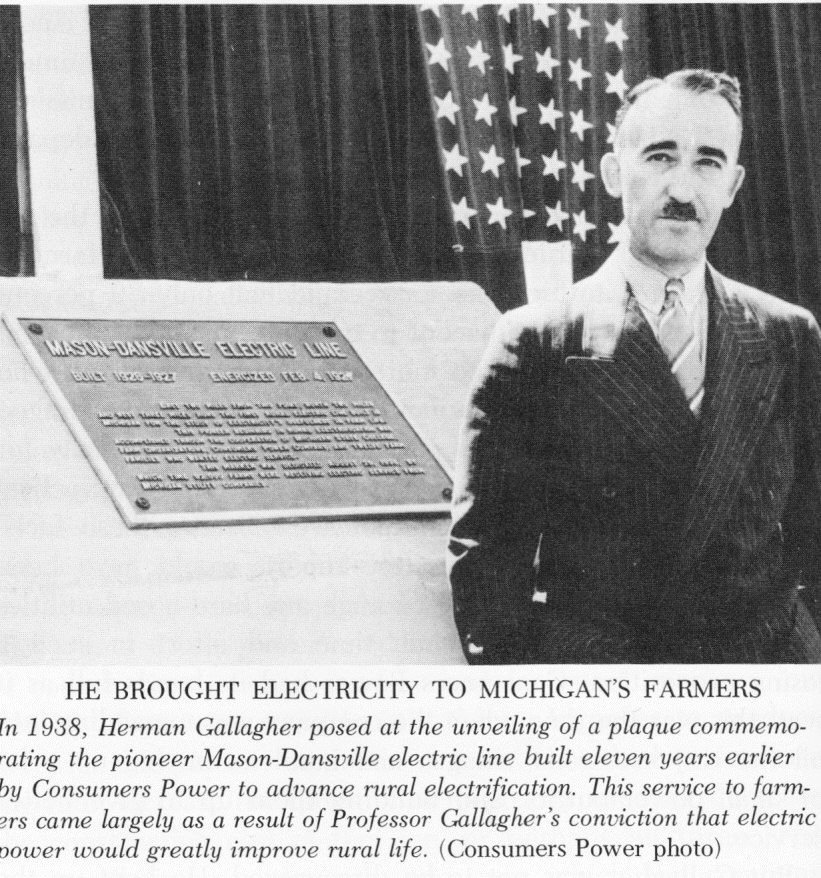
Herman J. Gallagher
Herman Joseph Gallagher was born December 16, 1891, on Mackinac Island to Thoams and Mary Eunice (Herman) Gallagher. He attended the grade schools on the Island, and would have graduated from high school around 1909.
Gallagher graduated from Michigan Agricultural College’s Agricultural Division in 1915. He was involved in the Union Literary Club, Farmers’ Club, J-Hop Committee, and ROTC as a student at MAC.
In 1916, Herman married Leone J. Dawley of Williamston, daughter of Lansing dentist Dr. Henry Dawley and Alice Dawley.
Following his graduation from MAC and marriage, Gallagher moved to Delhi Township, where he purchased a 100-acre farm on Miller Road, located at the northeast corner of Miller and Pennsylvania. He had a dairy operation there.
He taught three winters as a Short Course instructor of Farm Mechanics at Michigan Agricultural College. In 1923, Gallagher earned a Master of Agriculture degree from Michigan Agricultural College with a thesis titled “Relation of Farm Mechanics to the Farm.” In the thesis, he notes that this degree and thesis were the result of 7 years of work and research.
Gallagher remained with Michigan State College from his graduation through 1936 as an assistant professor and experimental project leader in the Agricultural Engineering Department. He also served on the Michigan Committee on Rural Electrification.
He became an internationally recognized expert in farm electrification. He was editor of the magazine “Electricity on the Farm,” authored numerous articles, experiment station publications, and conducted radio broadcasts on his work. He also worked as an expert with the U.S. Department of Agriculture.
Gallagher was the supervisor of the first rural electric line built in Michigan (and the world), for the study of electricity’s usefulness in farm life. It was built between Mason and Dansville in 1926 and 1927 and first energized on February 4, 1927. Professor H.H. Musselman, head of MAC’s Agricultural Engineering Department, tasked Gallagher with the project as a result of his expertise. The line was possible through a partnership between Michigan State College, Consumers Power Company, farm organizations, and 12 farm families desiring electric service. The line’s path extended from Mason, east down Columbia Road, south down Meridian Road, then east down M-36 into Dansville.
The project was paid for by Consumers Power, with no cost to farmers. Of the 33 farms along the route, 12 had their farms wired for power. Most farms that hooked up to electricity were solely using it for lighting, and not very much of it (less than 200 kilowatt-hours per month). Electricity for farm product was considered impractical, but not to Gallagher. MAC, Consumers, and Gallagher and his students supplied the farmers along the path with appliances and various mechanical equipment to test for use on the farm. The project was led by Gallagher as a laboratory for research at the college.
Over the subsequent decade, more than 92,000 Michigan farms had electricity. By October 1949, Michigan’s 100,000th farm was connected to electricity – a national first. By the 1950s, it was Gallagher’s estimation that almost every dairy farm with 10 or larger herd of cows milked by electric power.
A plaque commemorating the Mason-Dansville Electric Line was placed at the corner of M-36 and Meridian Road in 1938. Both Gallagher and Musselman were there to commemorate the success and impact the experimental line had on farm electrification.
During the 1936 Presidential election Wendell Willkie visited Michigan. During a meeting in Jackson on farm electricity, Gallagher told Willkie that refrigeration was the first important farm mechanization, to which Willkie responded “That’s dandy, just dandy… I want to get right on it.”
By 1936, Gallagher left MSC and joined Consumers Power Co. (now Consumers Energy) as the farm electrification supervisor. At this time the Gallagher family left their Miller Road farm and moved to Jackson where Consumers’ headquarters is located. The farm remained with the family, as Henry and Alice Dawley, Leone’s parents remained there until their deaths in the 1940s.
In 1938, Consumers Power received an award from the Edison Electric Institute for its contributions to rural electrification. Gallagher accepted the plaque on the company’s behalf in Atlantic City.
Throughout the rest of his career, Herman was the state service manager of Consumers Power Company, working as a global expert on electricity on farms.
Herman Gallagher died in 1956. Leone Dawley Gallagher died in 1965. The couple is buried in North Cemetery alongside Leone’s parents. The couple had four children – James H. Gallagher, Alice V. Gallagher Mayotte, Jean E. Gallagher Mayotte, and Thomas D. Gallagher.
